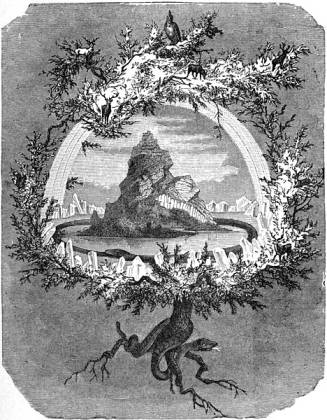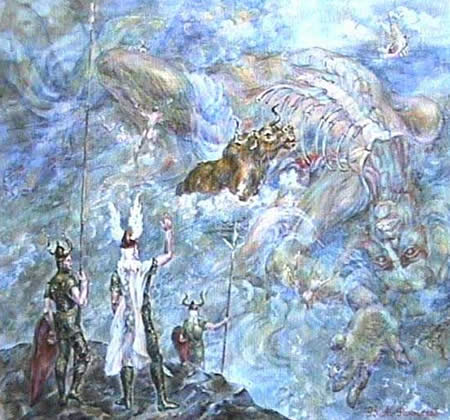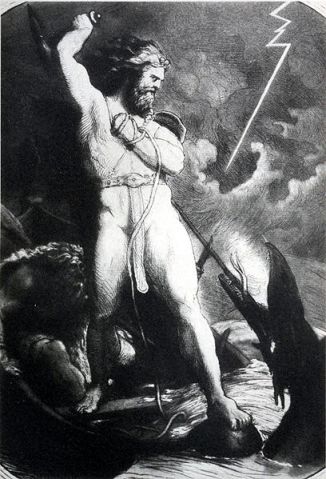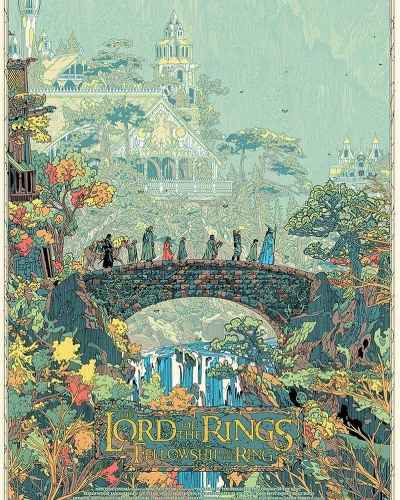Midgard, (Old Norse Miðgarðr) also known as “Middle-earth,” is a central part of Norse mythology. It is the place where we humans live and where the gods interact with or even manipulate us.
According to Norse cosmology, Midgard is one of the nine worlds, and it is located in the middle of the universe. In this article, I will explore the creation of Midgard, the role of the gods in the affairs of man, and the significance of Midgard in Norse cosmology, literature, and art.
The Creation of Midgard
The creation of Midgard is a central part of Norse mythology. According to the creation story, the gods first created Midgard, and then almost by accident created humans as well. The god Odin and his brothers Vili and Ve used the body of the giant Ymir to create the world. They used his body to create the land, his blood to create the oceans, and his bones to create the mountains. They then used his skull to create the sky and placed a fence (gardr) made from his eyelashes surrounding the edge of the world to keep out the giants.
This is described in different places, one is in the Poetic Edda poem Vafthruthnirsmal, stanza 21
Vafthruthnir spoke:
- “Out of Ymir’s flesh | was the earth created,
And the mountains were made of his bones;
The sky from the frost-cold | giant’s skull,
And the ocean out of his blood.”
The creation is also described in Snorri Sturluson’s Prose Edda. In the part called Gylfaginning (The Fooling of Gylfi) chapter 4 the creation process and all its gory details are included.
The significance of Midgard as a place for humans to live cannot be overstated. It is the only place where humans can exist, and it is where they are able to interact with the gods and other supernatural beings. This interaction plays a major role in shaping the mythology and beliefs of the Norse people.
Midgard and the Nine Worlds

Midgard is connected to the other eight worlds in Norse cosmology. Closest though are Asgard, the home of the gods, Jotunheim, the home of the giants, and Hel, the underworld. The significance of Midgard’s location in the middle world cannot be overstated. It is in the very center with the heavens and Asgard above and dark elves and even Hel below them.
According to Norse cosmology, the nine worlds are connected by the world tree, Yggdrasil. Midgard is located on the middle branch of Yggdrasil, and it is surrounded by the other eight worlds. Only through death would the Vikings travel to another of the nine worlds.
The lucky ones would end up in Valhalla, or in Freyja’s Folkvangr. However, the idea that people died and went to Folkvangr has some big holes in it. The less fortunate however would go to Hel or possibly drown and end up in the great hall of Ran.
Jotunheim and the world outside the fence
Midgard was placed in the center of the plane it was created on, surrounded by a great sea and outside of that lay Jotunheim. To the humans, the sea surrounding Midgard seemed so large as to be impossible to cross. Besides which, in the sea surrounding Midgard lived Jormungand the colossal and evil serpent. He was always ready to create havoc to anyone foolish enough to venture too far into the unknown.
With this knowledge it is possibly even more impressive that the Vikings were such great navigators, even discovering North-America. Sailing into the jaws of the beast, or possibly ending up in Jotunheim, a few Vikings dared where others faltered.
Had they not landed in the relative safety of Vinland (Greenland and Eastern Canada) they would have reached Jotunheim. It was positioned as great mountain ranges encircling the outer oceans, only accessible to the gods, and the jotnar themselves.
Creating Man and the Races of Man
After Odin, Vili and Ve had created Midgard, they set about creating life itself. Walking along the sea-shore one day, the three gods of creation came upon two pieces of driftwood. One was an ash, the other an elm, and they shaped the first into a man, the other a woman.

Odin, Vili and Ve bestowed special gifts upon their new creations. Odin gave them spirit, Vili gave them intelligence and movement, and Ve gave them appearance and senses. Ready to live on their own, Ask and Embla were decreed by the gods to live in Midgard.
While creating humankind is no small feat or gift to us humans, did Odin also have an ulterior motive even then? As we learn from later history, Odin is a warrior god, always adding to the ranks of the Einherjar. Without the humans, there would be no Einherjar warriors to fight on the day of Ragnarok.
It isn’t really clear when Odin became aware of their prophesied doom, or if he always knew. Any fears he might have had were confirmed both by the völva in the Völuspá and by the jötun Vafthruthnir. Either way, there was an almost symbiotic relationship between the gods and their worshipers in fighting a great evil.
Heimdall (or Odin) and the races of man
In a poem called Rigsthula or Rígsmál (The Song of Rig) the creation of different social classes of man is detailed. The origins of the poem, and even who the illusory god named Rig was is not entirely certain.
The poem is only found in a manuscript called Codex Wormanius, believed to have been written around the middle of the 14th century. It has an edition of Snorri Sturluson’s Prose Edda as well as a few additional poems. The Rigsthula is one of these additional poems.
In the prose introduction to the poem, it says that the god named Rig was Heimdall. However, this has later been contested by several scholars noting that the description of the god fits better with Odin.
On the other hand, in the Völuspá the völva names Heimdall as the kinsman, or ancestor to all greater and lesser men. This goes a long way towards supporting the prose introduction in the Rigsthula as Heimdall being the god in question. As it was written almost one hundred years after Snorri wrote the Prose Edda, the origins and true meaning of the poem will likely never be completely known.
Three social classes
In the poem, the god Rig goes wandering among the humans and visits three different families. They are of distinctly different wealth and status and this is reflected in everything from their clothes and manners to their food and appearance.
Nine months after each visit by Rig, the three couples have children and they are the first of the thralls (or serfs), the freemen (farmers and craftsmen) and the warrior nobles. Of these last, Rig actually came back and took a special interest in one young boy, giving him his own name. He would later launch wars to climb the social and wealth ladder, on the advice of the god Rig.
What actually became of the young Rig no one knows as the poem cuts off there and the rest is lost.
The Gods and the Affairs of Man
When looking at how the god Rig favored and helped the young Rig it bears a lot of resemblance with other instances where Odin meddles in the destinies of men. For example, in Grimnismál we have a very similar story where Odin, favoring one young boy over another, basically makes him king. Then, when Odin is mistreated by the then-grown man, he sees to it that he dies and his son, who helped Odin, is made king.
The gods in Norse mythology actually often intervene in the affairs of man. They are known to take sides in wars and conflicts, influencing the outcome of battles.
This is especially true for Odin, who through his Valkyries can be very influential in the outcome of battles. An interesting and gory description of this is the poem The Song of the Spear. In it, an eyewitness describes seeing twelve Valkyries working a war-woof (weaving apparatus) to decide the outcome of a battle.
Odin is primarily using humans as recruits for his ever-growing army of Einherjar. They are training in eternity, for one day to fight alongside him and the other gods when Ragnarok happens.
Thor the Protector of Midgard
If Odin is the warrior god, he is decidedly more on the side of the nobles, the ones waging war. For the common man, however, Thor was a favored god. He was seen as a protector of Midgard and humans against primarily the jotnar, but also other possible dangers.

Thor is the god of thunder and is known for his fierce battles against the giants. He is also a protector of humans and is often called upon in times of war and conflict. Interestingly, so too was his daughter Thrud.
On an ancient rune stone from Gotland, Sweden, placed by the burial mound of a chieftain Thrud is mentioned. Part of the inscription relays that he was a “battle-tree of Þrúðr”. This is seen as meaning he was a great warrior and follower of Thrud.
In much the same way as Odin, Thor and even Thrud might help men in battles, all the other gods were associated with different responsibilities and powers. The way the Norse practiced their religion does seem to have been pragmatic and almost transactional in how they worshiped. Offerings would be made and deals struck with the gods to gain their favor.
The Role of Midgard in the End Times
The role of Midgard in Ragnarok, the literal end of the world, is significant. According to the stories, Midgard will be completely destroyed during the final battle between the gods and giants. This battle will result in the deaths of many of the gods, as well as the majority of the human inhabitants of Midgard.
During Ragnarok, the giant serpent Jormungandr will rise from the sea and poison the land, the wolf Fenrir will devour the living, and the fire giant Surt will burn the world. In the end, only two humans will survive and will be able to start a new world.
This is detailed in the Poetic Edda poem Vafthruthnirsmal stanza 44 and 45:
Odin spoke:
- “I have traveled much | I have seen much,
Much have I got of the gods:
Who will survive of mankind | when at last there comes
The mighty winter to men?”
Vafthruthnir spoke:
- “In Hoddmimir’s wood | shall they hide
Lif and Lifthrasir then;
The morning dews | will provide food for them,
Such food shall men then find.”
The fate of the human inhabitants of Midgard during Ragnarok highlights the importance of the gods in Norse mythology. The gods, who created and have protected humans throughout their lives, will ultimately be responsible for their destruction.
Midgard in Popular Culture and Literature
Norse mythology has had a great impact on both literature and popular culture. Maybe especially so the idea of Midgard, or Middle Earth. This concept of a middle world between the realms of the gods and the underworld has been a recurring theme in literature and media.

One of the most notable examples of this is J.R.R. Tolkien’s “The Lord of the Rings” series. The world of Middle Earth, where the story takes place, is heavily influenced by Norse mythology. The name itself is a direct reference to Midgard. Similarly, J.K. Rowling’s “Harry Potter” series also features a hidden magical world within our own, similar to the concept of Midgard being a world where magic was all around the humans at all times.
The idea of Midgard as a parallel world has also been used in other popular fantasy series such as “The Chronicles of Narnia” and “The Wheel of Time” as well as in video games like “God of War” series and “The Elder Scrolls V: Skyrim”. Even in the Marvel Cinematic Universe, the realm of Asgard, home of the Asgardians and Thor, is considered to be one of the Nine Realms, where Midgard is one of the realms and where the human race lives.
Overall, the concept of Midgard from Norse mythology has been a major inspiration for fantasy and science fiction authors, filmmakers, and game designers, as it provides a rich source of inspiration for creating parallel worlds and hidden realms within our own. It also serves as a reminder that there may be more to our world than what we can see and understand.
Comparison of Midgard in Norse Mythology to other cultures
Midgard can be compared to other cultures’ concepts of the middle world or earth. In many cultures, there is a belief in a middle world where humans live and where the gods interact with them. This possibly illustrates earlier humans’ die hard belief that we were in the center of all things.
For example, in Greek mythology, there is much the same concept of the mortal world, or the “earth,” where humans live and where the gods interact with them through various means such as oracles and myths. There too is the underworld, Hades, and the gods live on Olympus, high up in the heavens.
Much like the gods of ancient Greece, the Norse gods are quite active in the world of men. Taking sides in battles, causing natural disasters, favoring one against another and being responsible for deaths. Often on a whim, people would die, or have their lives altered irreparably by a god with a grievance.
Parting Thoughts On Midgard
Midgard is a natural central part of Norse mythology being the home to us humans. The gods’ view of Midgard and their interactions with humans shape the mythology and their fate during Ragnarok highlights the importance of the gods in Norse mythology.
The ongoing relevance of Norse mythology can be seen in its influence on later fantasy and science fiction works and the continued interest in the stories and beliefs of the ancient Scandinavian and Germanic cultures. Overall, Midgard is a fundamental concept in Norse mythology, one that highlights the importance of the gods in shaping the fate of the world and the humans living in it.
Featured Image Credit: heimdallsraunen
